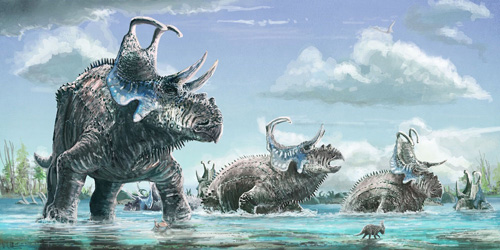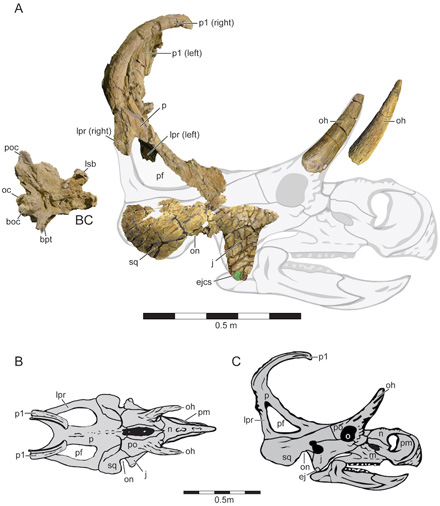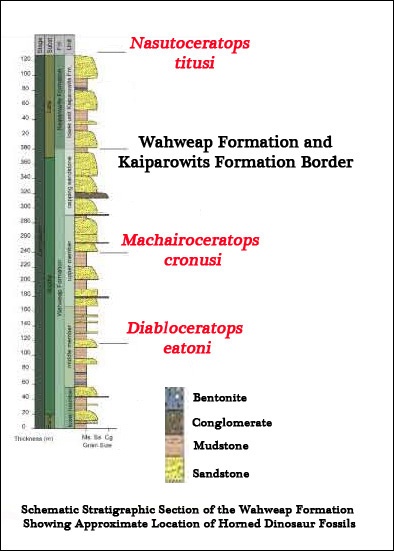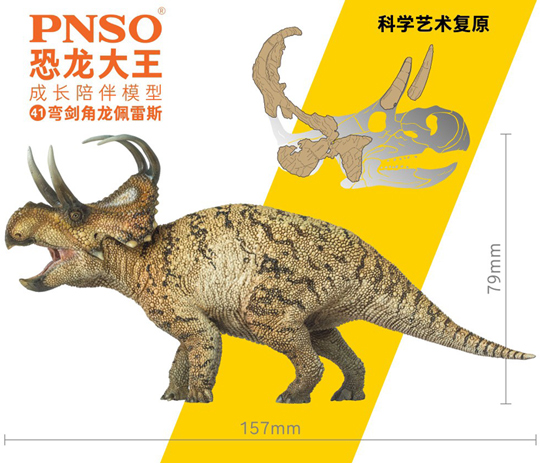Machairoceratops Plugs a Four-Million-Year Gap
Machairoceratops cronusi – “Bent Sword Horned Face”
The discovery of skull bones that have proved to represent a new species of Late Cretaceous horned dinosaur has helped palaeontologists to plug a four-million-year gap in the Ceratopsidae fossil record. Researchers, writing in the on line, open access journal PLOS One, describe Machairoceratops cronusi, believed to be relatively basal member of the centrosaurine group of horned dinosaurs. The fossils, from Utah, help to fill an evolutionary gap in the horned dinosaur fauna known from southern Laramidia, with Machairoceratops fitting in between the earlier centrosaurine Diabloceratops and the later centrosaurine Nasutoceratops.
An Illustration of the Bizarre Bent-Horned Centrosaurine Machairoceratops cronusi
Picture credit: Mark Witton
Machairoceratops cronusi
A wide variety of North American ceratopsid dinosaurs have been described over the last decade or so. Last week for example, Everything Dinosaur reported on the discovery of a new species of horned dinosaur from the Judith River Formation of Montana – Spiclypeus shipporum. To read an article about this dinosaur: New Horned Dinosaur from the Late Cretaceous of Montana.
A field team first unearthed fragments that represented elements of the skull in 2006 at the famous Grand Staircase-Escalante National Monument, in southern Utah. A further three seasons in the field were required to complete the exploration, sadly no post cranial material could be found. However, from the configuration of the epiparietals and the horn cores the scientists were soon convinced that they had found a new species.
The Fossils of Machairoceratops cronusi and a Ghost Outline of the Complete Skull
Picture credit: Lund et al (PLOS One)
The picture above shows (A) a right lateral view of the fossil material associated with Machairoceratops cronusi mapped against a ghosted outline of the inferred skull. To the left of the picture the braincase (BC) is shown. Diagram B shows the skull in dorsal view, whilst diagram C shows a complete reconstruction of the entire skull, note the curvature of the central parietals (p1 left and p1 right), it is these curved elements that gave this dinosaur its name.
Head Spikes More than a Metre Long
Each curved head spike (represented by p1 left and p1 right in diagram A above), would have measured around 1.2 metres in length, that’s slightly longer than a driver in a set of golf clubs used by a professional, male golfer. However, despite this impressive headgear, the researchers estimate that Machairoceratops was not huge by horned dinosaur standards. Based on skull comparisons with more complete specimens, palaeontologists have suggested that this dinosaur would have been around six metres in length and would have weighed around two tonnes.
Lead author of the scientific paper, graduate student Eric Lund (Ohio University Heritage College of Osteopathic Medicine), suggests that the head crest ornamentation may have had a role in visual signalling, such as selecting mates and establishing a social position within the herd.
Stratigraphic Assessment of the Position of Machairoceratops in Relation to Other Horned Dinosaur Fossils
Picture credit: Lund et al (PLOS One) with additional notation by Everything Dinosaur
Filling a Four-million-year Gap in the Centrosaurinae
The discovery of M. cronusi in strata that was laid down some 77 million years ago has helped to plug a four-million-year gap in the centrosaurine fossil record from the Grand Staircase-Escalante National Monument. Fossils of an earlier centrosaurine called Diabloceratops eatoni have been found in rocks that date to around 80 million years ago. The fossil material related to Machairoceratops fills the gap between Diabloceratops and the later, almost equally bizarrely horned centrosaurine Nasutoceratops titusi, whose fossils are associated with the overlying Kaiparowits Formation and date to around 75-76 million years ago.
Commenting on the naming of this new type of Late Cretaceous herbivorous dinosaur, Eric Lund stated:
“The finding fills in an important gap in the fossil record of southern Laramidia, an area that included Utah, Colorado, New Mexico, Texas and Mexico during the Late Cretaceous period. The discovery of Machairoceratops not only increases the known diversity of ceratopsians from southern Laramidia, it also narrows an evolutionary information gap that spans nearly 4 million years between Diabloceratops eatoni from the lower middle Wahweap Formation and Nasutoceratops titusi.”
A Model of a Machairoceratops (PNSO)
The Chinese model manufacturing company PNSO have introduced a replica of Machairoceratops.
To view this range: PNSO Age of Dinosaurs.
Once again, palaeontologists have gained fresh insight to the amazing diversity and variety of horned dinosaurs from North America. The genus name is from “ceratops”, meaning horned face and the Greek “machairis” for bent sword, in deference to those curved central parietals. The species name is from the mythical Greek titan (Cronus, also known as Kronos), whose symbol is a scythe or curved sword.





